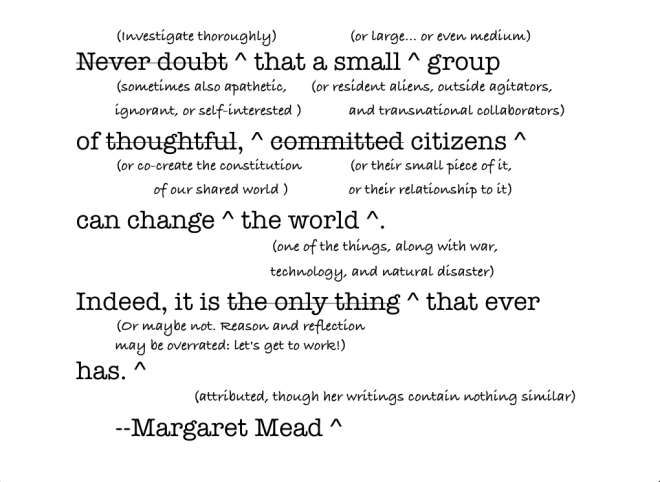In DC over the last few days, it was frequently the case that the side-walks were cleared and the roads were not. Yet the roads are plowed by paid contractors driving massive machines while the sidewalks are usually shoveled by residents working for free (or neighbors paid by the residents individually.) What gives? Why do the paid, centrally managed snow removal contractors work so much slower than the the ordinary, non-professional residents?
Put another way, why was I able to convince my neighbors we could (and should) shovel our street out when the plows didn’t come? When they realized that others were doing it, they realized that rather than clear out the whole street, they’d just need to do their small part. They were even willing to shovel the few stretches of homes whose owners didn’t join us, because we couldn’t traverse that territory without helping the slackers.
I’d argue that this is a classic case of common pool resource management. But a shoveled sidewalk is a strange sort of common pool resource: it’s not like fisheries or irrigation where the more one person uses the resource, the less there is for others. That is, it’s not precisely “rivalrous,” one of two conditions required for a common-pool resource to flourish. In fact, the more people shovel their sidewalks, the better off each individual with a shoveled sidewalk is. This is what economists call “anti-rivalry” and is frequently linked to network effects: the more people use email or Facebook, the more useful email or Facebook are.
The other condition for a common-pool resource is that the resource must be “non-excludable.” Shoveled parking spaces in DC are frequently protected in this way: a chair or a trash can signals that by dint of shoveling the spot it has become my exclusive property for the duration of the snow.
Parking spots are excludable (even if only through threats) and they’re rival: only one of us can park there at a time. Thus, the standard matrix analysis calls them private goods. This is tricky: the street below the snow was a public good, usually, but the act of shoveling seems to give someone the sense that they have a private ownership interest in it. (I mixed my labor with it!) Yet there’s never enough parking spots unless we share them, and short-term visitors are in an especially difficult situation.
You’d think that rivalry and anti-rivalry would be as opposed as that “anti” suggests. But from the perspective of the structures of ownership and distribution, it does seem like anti-rival goods work on the same model as other common pool resources that are rival: thus Lawrence Lessig used anti-rivalry to argue for free open source software, which is how much of the backbone software of the internet was developed. Rather than apportioning a scarce resource, an anti-rival network has to distribute it as widely as possible to realize maximal benefits:
It’s not just that code is non-rival; it’s that code in particular, and (at least some) knowledge in general, is, as [Steven] Weber calls it, ‘anti-rival’. I am not only not harmed when you share an anti-rival good: I benefit.
This continues to produce the standard insider/outside dynamic of a common-pool resource management system, but replaces exclusivity with evangelism. The plow system is just another version of what Elinor Ostrom called “crowding out”:
Citizens are effectively told that they should be passive observers in the process of design and implementation of effective public policy. The role of citizenship is reduced to voting every few years between competing teams of political leaders. Citizens are then supposed to sit back and leave the driving of the political system to the experts hired by these political leaders.
Some of what makes anti-rival goods work is peer pressure: when we were shoveling the street, a few parents came out and confessed apologetically that they couldn’t leave their children alone to come help. The tone of their apologies suggested that there was some guilt involved. But a lot of it was that a simply impossible job became imaginable if each neighbor was able to see that they’d personally benefit: as the shoveled portion of the street expanded, the neighbors in the middle of the block came outside to shovel still farther, since they’d only have a little bit more to do to enjoy the benefits.
The plows came Wednesday afternoon and expanded our cleared lanes. But we had already escaped!






